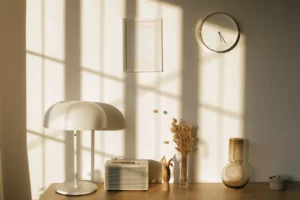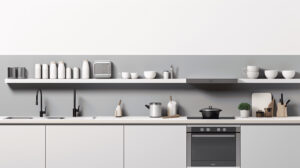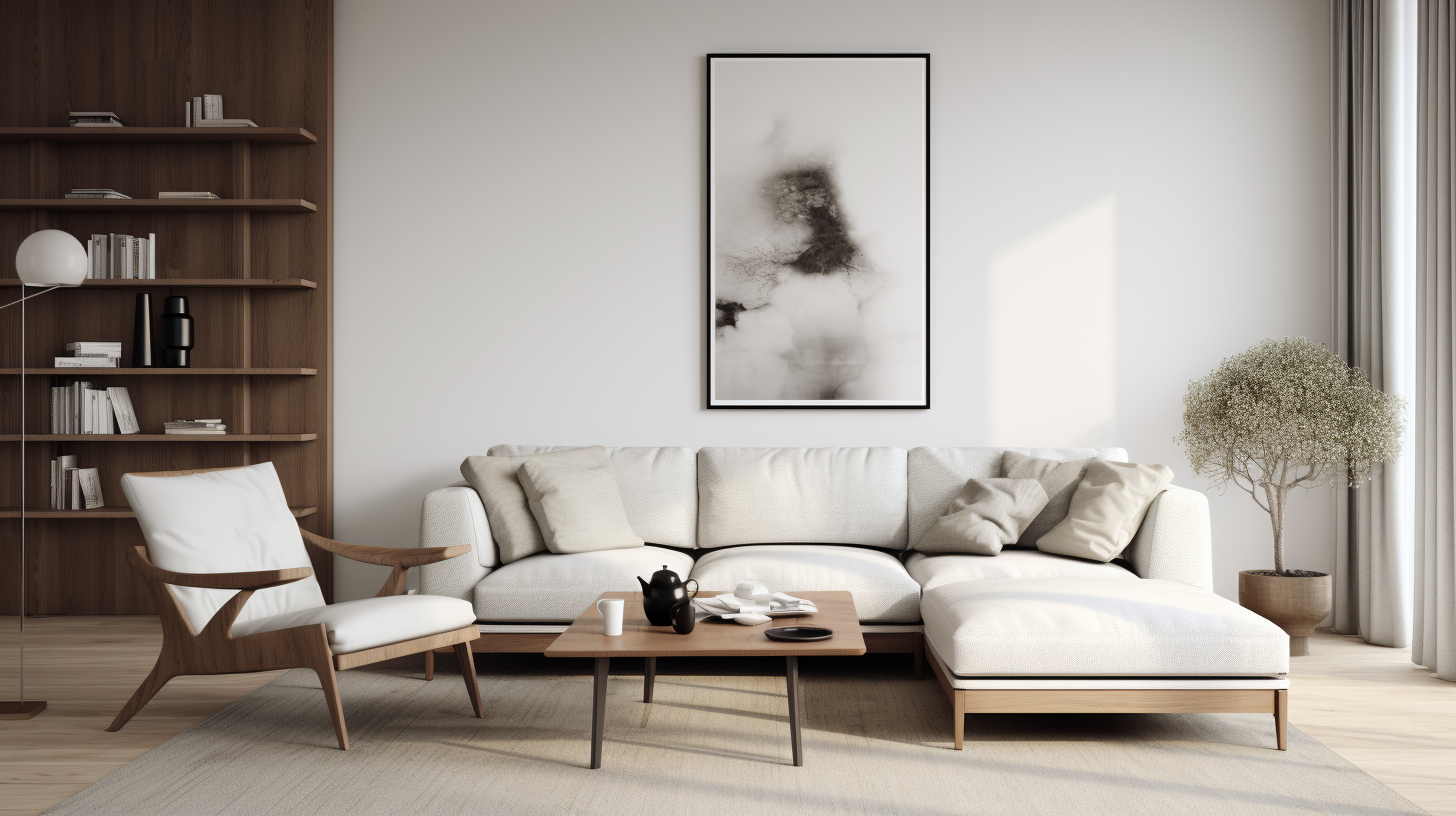Welcome to the world of minimalist design! Are you tired of living in a cluttered and chaotic space? Do you find yourself longing for a sense of calm and simplicity in your home? Then you’ve come to the right place. In this article, we will explore the concept and how you can incorporate minimalist design into every room of your home.
Minimalism is not just a design trend; it is a way of life. It is about paring down to the essentials, removing unnecessary clutter, and creating a space that is clean, organized, and functional. By embracing minimalist design principles, you can create a serene and peaceful environment that promotes relaxation and clarity of mind.
Whether you live in a small apartment or a spacious house, minimalist design can transform your space into a tranquil sanctuary. Not only will it make your home look aesthetically pleasing, but it will also have a positive impact on your mental and emotional well-being. So, let’s dive in and explore the world of minimalist design!
Understanding Minimalism

Key Principles of Minimalist Design
Minimalism is a design philosophy that focuses on simplicity, functionality, and the elimination of excess. It embraces clean lines, neutral colors, and minimal decoration to create spaces that are calm, clutter-free, and visually appealing. Understanding the key principles of minimalist design will help you incorporate this aesthetic into every room of your home.
Here are some key principles to consider when embracing minimalism:
- Simplicity: The foundation of minimalist design is simplicity. It involves stripping down a space to its essential elements and eliminating anything that is unnecessary or visually overwhelming.
- Functionality: Minimalist design prioritizes functionality. It emphasizes practicality and ensures that every item or piece of furniture serves a purpose, allowing for efficient use of space.
- Neutral Color Palette: Neutral colors are a staple of minimalist design. Whites, beiges, grays, and earth tones create a sense of calm and provide a clean backdrop for the room. This allows the focus to be on the essential elements of the space.
- Clean Lines: Minimalist design favors clean, straight lines. Furniture and décor should have simple and straight profiles, avoiding ornate details or excessive decoration.
- Decluttering: Clutter is the opposite of minimalism. Regular decluttering is essential to maintain a minimalist space. It involves removing unnecessary items and organizing belongings in a deliberate and tidy manner.
Benefits of Minimalist Design
Minimalism offers numerous benefits beyond just visual appeal. Incorporating minimalist design into your home can have a positive impact on your lifestyle and well-being. Here are some benefits of minimalist design:
- Reduced Stress: A cluttered and visually overwhelming environment can contribute to stress and anxiety. By simplifying your home and creating a minimalist space, you can create a calm and peaceful retreat that promotes relaxation.
- Increased Productivity: A clutter-free workspace can enhance your focus and productivity. With minimal distractions, you can better concentrate on your tasks and achieve better results.
- Better Organization: Minimalism encourages intentional organization. By decluttering and organizing your belongings, you can find what you need easily and maintain a tidy and organized space.
- Improved Aesthetics: Minimalist design offers a timeless and sophisticated aesthetic. The clean lines and neutral color palettes create a visually pleasing environment that can elevate the overall look of your home.
- Sustainable Living: Minimalism promotes a more sustainable lifestyle. By embracing quality over quantity and mindful consumption, you can reduce waste and make more environmentally conscious choices.
Incorporating minimalist design principles in your home can transform your living spaces and improve your overall well-being. Whether you are looking to create a serene bedroom or an organized kitchen, minimalism provides a framework to achieve a clutter-free and visually appealing home.
Minimalist Design in the Living Room

The living room is often the focal point of a home, where family and friends gather to relax and socialize. Incorporating minimalist design principles in this space can create a clean and serene environment that promotes calmness and clarity. Here are some tips for incorporating minimalist design in your living room:
Choosing Simple and Functional Furniture
- Opt for clean lines: Choose furniture pieces with clean and simple lines to maintain a minimalist aesthetic. Avoid ornate or overly decorative designs.
- Focus on functionality: Select furniture that serves a purpose and eliminates unnecessary clutter. Choose pieces that offer practical storage solutions or multifunctional features.
- Limit the number of furniture pieces: Keep the number of furniture pieces to a minimum to create an open and spacious feel in the room. Avoid overcrowding the space with bulky or oversized furniture.
Neutral Color Palettes
- Stick to a neutral color scheme: Choose a neutral color palette, such as whites, grays, and beige, to create a calming and cohesive atmosphere. Avoid bold or vibrant colors that can be visually overwhelming.
- Add pops of color sparingly: If you want to incorporate a splash of color, do so sparingly through accent pieces like throw pillows or artwork. This helps maintain the overall minimalist aesthetic while adding a touch of personality.
Decluttering and Organizing Tips
- Remove unnecessary items: Declutter your living room by removing items that don’t serve a purpose or contribute to the overall design. Keep only the essentials.
- Utilize smart storage solutions: Invest in storage solutions that keep belongings out of sight, such as built-in shelving units or hidden storage ottomans. This helps maintain a clean and clutter-free space.
- Create designated spaces: Designate specific areas for different activities, such as reading or watching television. This helps create a sense of order and purpose in the room.
By following these tips, you can create a minimalist living room that is both visually appealing and functional. Remember, less is more when it comes to minimalist design. Focus on simplicity, functionality, and creating a space that promotes relaxation and clarity.
Minimalist Design in the Bedroom

The bedroom is a sanctuary, a place where we can relax and retreat from the world. Adopting minimalist design principles in the bedroom can help create a calm and tranquil space that promotes restful sleep and enhances overall well-being. Here are some tips on how to incorporate minimalist design in your bedroom:
Simplifying the Bedding
One of the key aspects of minimalist design in the bedroom is keeping the bedding simple and uncluttered. Opt for clean and crisp bedding with neutral colors or subtle patterns. Avoid excessive throw pillows and decorative cushions that can create visual clutter. Stick to a minimal number of pillows that serve a functional purpose, such as providing support for reading or sleeping.
Creating an Organized Closet Space
A clutter-free and well-organized closet can contribute to a minimalist bedroom design. Take the time to declutter your wardrobe and only keep items that you truly love and regularly wear. Invest in storage solutions, such as hanging shelves or drawers, to keep your clothes and accessories neatly organized.
Using Soft Lighting
Lighting plays a crucial role in setting the mood and ambiance of a room. In a minimalist bedroom, opt for soft and warm lighting that creates a cozy and calming atmosphere. Avoid harsh overhead lights and instead opt for bedside lamps or wall sconces with adjustable brightness. Consider incorporating dimmers to have control over the intensity of the light.
Pro Tip: Add a touch of nature to your minimalist bedroom by placing a few indoor plants or fresh flowers on a bedside table or windowsill. Not only will they add a pop of color, but they will also help purify the air and create a sense of tranquility.
Incorporating Natural Materials
In a minimalist bedroom, the use of natural materials can help create a sense of harmony and connection to the environment. Consider incorporating wooden furniture pieces, such as a bed frame or a nightstand, that have simple and clean lines. Opt for natural fiber rugs or curtains to add texture and warmth to the space.
Did You Know? When it comes to the color palette of a minimalist bedroom, stick to neutral tones such as whites, grays, and earthy tones. These colors create a calming and serene environment, promoting a good night’s sleep.
By incorporating minimalist design principles in your bedroom, you can create a serene and clutter-free space that promotes relaxation and ensures a good night’s sleep. Simplify your bedding, organize your closet, use soft lighting, and incorporate natural materials to create a harmonious and inviting atmosphere in your bedroom. Remember, less is more when it comes to minimalist design!
Minimalist Design in the Kitchen

When it comes to incorporating minimalist design in your kitchen, the key is to create a space that is functional, clean, and clutter-free. By streamlining your kitchen and focusing on simplicity, you can create a serene and inviting space that is both stylish and efficient. Here are some tips to help you achieve a minimalist kitchen design:
Streamlined Kitchen Appliances
One of the main aspects of minimalist design is the use of simple, streamlined appliances. Opt for appliances that have a sleek and minimalist look, with clean lines and minimalistic controls. This will not only enhance the overall aesthetic of your kitchen but also make it easier to clean and maintain.
Efficient Storage Solutions
In a minimalist kitchen, it’s important to have efficient storage solutions that keep your countertops free from clutter. Consider installing cabinets with clean lines and concealed hardware to maintain a sleek and clutter-free look. Utilize drawer dividers and organizers to keep your utensils and tools neatly arranged. Maximize vertical space with open shelves or wall-mounted racks for items that you use frequently.
Clean and Simple Countertops
To create a minimalist look in your kitchen, it’s important to have clean and clutter-free countertops. Keep only the essentials on display, such as a few decorative items or a potted plant. Store small appliances and kitchen gadgets out of sight when not in use. Choose countertops with a smooth and seamless finish, such as stainless steel or quartz, which are low-maintenance and easy to clean.
By incorporating these minimalist design elements in your kitchen, you can create a space that is not only beautiful but also functional and clutter-free. Remember, the key is to focus on simplicity and to keep only what is necessary for your daily cooking needs. Embrace clean lines, efficient storage solutions, and a clutter-free countertop to achieve the minimalist kitchen of your dreams.
Tips for Minimalist Design in the Kitchen
- Choose simple and streamlined kitchen appliances
- Opt for efficient storage solutions to keep countertops clutter-free
- Keep countertops clean and simple with minimal items on display
- Select countertops with a smooth and seamless finish
- Embrace simplicity and focus on what is necessary for daily cooking needs
So, go ahead and declutter your kitchen, streamline your appliances, and create a minimalist kitchen design that is both functional and visually appealing. Remember, less is more when it comes to minimalist design, and by incorporating these tips, you can create a kitchen space that is both stylish and serene.
Minimalist Design in the Bathroom

The bathroom is often a space that can easily become cluttered with toiletries, towels, and other personal items. However, incorporating minimalist design principles into your bathroom can create a streamlined and calming environment. Here are some tips for achieving a minimalist bathroom design:
Sleek and Minimalist Fixtures
When it comes to faucets, showerheads, and other fixtures in your bathroom, opt for sleek and minimalist designs. Choose fixtures with clean lines and a simple aesthetic to create a visually appealing and clutter-free space. Avoid ornate or intricate designs that can disrupt the minimalist feel of the bathroom.
Organizing Toiletries and Personal Items
To maintain a minimalist look in your bathroom, it’s important to keep your toiletries and personal items organized. Use storage solutions such as baskets, trays, or drawer organizers to store your items and keep them out of sight. Keep only the essentials on your countertops and store any excess items in a cabinet or closet.
Incorporating Natural Elements
Bringing in natural elements can add warmth and texture to your minimalist bathroom design. Consider adding plants, such as small succulents or air plants, to bring a touch of nature into the space. Bamboo or wooden accessories, such as a soap dispenser or toothbrush holder, can also add a natural element to the bathroom.
“In a minimalist bathroom, less is more. Stick to simple fixtures, keep your toiletries organized, and add natural elements for a calming and clutter-free space.”
Minimalist Design in the Home Office

Working from home has become increasingly popular, and having a well-designed home office is crucial for productivity and focus. Implementing minimalist design principles in your home office can create a clean, serene, and organized space that promotes efficiency and creativity. Here are some tips on how to incorporate minimalist design in your home office:
Clutter-Free Workspace
A cluttered workspace can hinder your ability to concentrate and be productive. To create a minimalist home office, start by decluttering and organizing your workspace. Remove any unnecessary items and only keep essential items on your desk. Invest in storage solutions such as drawers and shelves to store paperwork, office supplies, and other items out of sight.
Minimalist Desk and Storage Solutions
When choosing furniture for your home office, opt for minimalist desk and storage solutions. Look for clean lines and simple designs. A sleek and minimal desk can be the centerpiece of your home office. Consider a desk with built-in storage space or a floating desk to maximize space and minimize visual clutter.
Optimizing Natural Light
Natural light is essential for a productive and refreshing workspace. Position your desk near a window to take advantage of natural light. Remove heavy curtains or blinds and opt for sheer or light-colored window treatments to allow more light into the room. If your workspace doesn’t have access to natural light, consider using lighting fixtures with warm and soft light to create a calm and inviting ambiance.
“A cluttered desk is a cluttered mind. Keep your workspace clean and organized to improve focus and productivity.”
Personalizing with Minimalist Decor
While minimalist design emphasizes simplicity and minimalism, it doesn’t mean your home office should lack personality. Incorporate minimalist decor elements that align with your style and preferences. Choose a few carefully curated artworks, plants, or meaningful objects to add a personal touch to your workspace. Remember to keep it simple and clutter-free, ensuring that these decor items enhance rather than distract from your productivity.
Ergonomic Considerations
In addition to minimalist design, it’s essential to prioritize ergonomics in your home office setup. Invest in an ergonomic chair that provides proper support for your back and promotes good posture. Consider a height-adjustable desk that allows you to alternate between sitting and standing for a healthier work routine. Choose ergonomic keyboard and mouse setups to minimize strain on your wrists and hands.
Creating a Calm and Focused Atmosphere
Finally, create a calm and focused atmosphere in your home office by incorporating elements that promote relaxation and concentration. Add a small water fountain or indoor plants to bring a sense of tranquility. Use natural materials such as wood or bamboo for furniture and accessories to enhance a connection with nature. Consider using aromatherapy diffusers or candles with soothing scents like lavender or eucalyptus to create a serene environment.
By implementing minimalist design principles in your home office, you can create a space that fosters creativity, concentration, and productivity. Remember to declutter, choose minimalist furniture, optimize natural light, personalize with minimalist decor, prioritize ergonomics, and create a calm atmosphere. Enjoy a clutter-free and inspiring workspace that supports your work-at-home journey.
Incorporate Minimalist Design Elements

Minimalist design is all about simplicity, functionality, and a clutter-free environment. Incorporating minimalist design elements into your home can create a peaceful and serene atmosphere. Here are some key ways to bring minimalist design into your space:
Use of Lines and Geometric Shapes
- Minimalist design often incorporates clean lines and geometric shapes. Incorporate these elements into your home by choosing furniture with simple, straight lines and geometric patterns.
- Opt for furniture with minimal ornamentation or decoration. Remember, less is more when it comes to minimalism.
- When selecting wall art or decor, choose pieces that feature geometric shapes or simple line drawings. This adds visual interest without overwhelming the space.
Embracing Negative Space
- Negative space refers to the empty spaces in a room. Embracing negative space is a key principle of minimalism, as it creates a sense of openness and allows your eye to rest.
- Avoid overcrowding your space with furniture or accessories. Leave breathing room between pieces to create a sense of balance and calm.
- When arranging furniture, consider leaving empty space around each piece. This creates a minimalist and open feel.
Utilizing Natural Materials
- Minimalist design often incorporates natural materials such as wood, stone, and metal. These materials add warmth and texture to a space.
- Choose furniture made from natural materials, such as a wooden coffee table or a stone countertop.
- Incorporate natural textures through rugs, pillows, or throws. Look for materials like linen or cotton, which add a soft and natural feel.
- When selecting colors, opt for earth tones or neutrals that mirror nature’s palette. This creates a calming and cohesive atmosphere.
Remember, incorporating minimalist design elements into your home is about creating a space that brings you peace and tranquility. It’s not about getting rid of everything you own, but about carefully curating the items you have and creating a clutter-free environment. Enjoy the process of simplifying and creating a minimalist oasis in your own home!
Maintaining a Minimalist Lifestyle

Once you’ve incorporated minimalist design into your home, it’s important to maintain a minimalist lifestyle to truly embrace the essence of minimalism. Here are some tips on how to do just that:
Regular Decluttering Practices
- Schedule regular decluttering sessions to keep your home organized and free from unnecessary clutter.
- Set aside a specific time each month to go through your belongings and get rid of things you no longer need or use.
- Donate or sell items that are in good condition, and responsibly dispose of items that are no longer usable.
- Remember, minimalism is all about living with less, so strive to keep only the essentials in your home.
Mindful Consumption Habits
- Take a thoughtful approach to your shopping habits. Before making a purchase, ask yourself if you truly need the item and if it aligns with your minimalist lifestyle.
- Consider the environmental impact of your purchases and opt for sustainable and ethically sourced products whenever possible.
- Avoid impulse buying and practice intentional shopping, focusing on quality over quantity.
- Be mindful of your consumption habits and resist the temptation of unnecessary purchases.
Embracing Quality over Quantity
- Instead of owning numerous items that serve the same purpose, invest in high-quality, multifunctional pieces that will last longer.
- Choose items that are built to withstand the test of time and are timeless in design.
- Prioritize experiences and relationships over material possessions. Instead of accumulating more stuff, focus on creating memories and enjoying meaningful moments.
- Shift your mindset from acquiring more things to valuing the things you already have.
By incorporating these practices and embracing a minimalist lifestyle, you can continue to enjoy the benefits of minimalism beyond just the design of your home. Minimalism is not just about having a clean and clutter-free space, but also about having a clear mind and a sense of calm and contentment in your everyday life. So, start embracing minimalism today and experience the transformative power it can bring to your life.
“Minimalism is the intentional promotion of the things we most value and the removal of everything that distracts us from it.” – Joshua Becker
Also read; Minimalist Living Room Inspiration: Design Ideas for First-time Homeowners in 2023
Conclusion
Incorporating minimalist design principles into your home can transform your living spaces into peaceful, clutter-free sanctuaries that promote a sense of calm and balance. By simplifying your surroundings and prioritizing functionality and purpose, you can create a space that is both visually appealing and highly practical.
Remember, minimalism is not about sacrificing style or character; it’s about choosing quality over quantity and curating your space with intention. By following the tips and techniques outlined in this article, you can achieve a minimalist aesthetic in every room of your home.
Embracing a minimalist lifestyle goes beyond just design. It encourages a shift in mindset and habits as well. Regular decluttering, mindful consumption, and valuing experiences over material possessions are key aspects of maintaining a minimalist lifestyle.
So, whether you want to create a serene living room, a clutter-free bedroom, a streamlined kitchen, a spa-like bathroom, or a productive home office, incorporating minimalist design elements will help you achieve a space that is clean, functional, and visually stunning.
Remember, minimalism is a journey, not a destination. Take it one step at a time, and enjoy the process of simplifying and creating a home that truly reflects your values and personal style. Start by applying these ideas to one room at a time and gradually extend them to other areas of your home.
By embracing minimalism, you’ll not only create a visually pleasing home but also enjoy the benefits of reduced stress, increased focus, and a greater appreciation for the things that truly matter in life. So, what are you waiting for? Start decluttering, simplify your space, and embrace the beauty of minimalism in your home today!
Frequently Asked Questions
- What is minimalist design?Minimalist design is a style that focuses on simplicity, clean lines, and a decluttered aesthetic. It involves using only essential elements and removing anything unnecessary or excessive.
- Why should I incorporate minimalist design in my home?Incorporating minimalist design in your home can create a sense of calm, promote better focus, and reduce visual clutter. It can also make your space feel more spacious and organized.
- How can I start incorporating minimalist design in my home?To start incorporating minimalist design in your home, begin by decluttering and getting rid of unnecessary items. Choose a neutral color palette, opt for simple furniture with clean lines, and maximize natural light. Focus on quality over quantity.
- What are some key elements of minimalist design?Key elements of minimalist design include simplicity, functionality, clean lines, ample open space, neutral color palettes, and a focus on essential furniture and decor.
- Can I still have personal touches in a minimalist design?Yes, you can still incorporate personal touches in a minimalist design. Select a few meaningful and high-quality decor pieces or art that reflect your personality or interests, while keeping the overall design simple and uncluttered.

